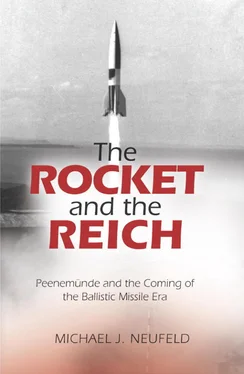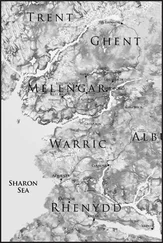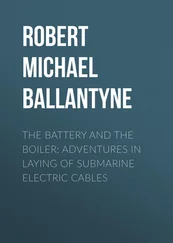Michael Neufeld - The Rocket and the Reich
Здесь есть возможность читать онлайн «Michael Neufeld - The Rocket and the Reich» весь текст электронной книги совершенно бесплатно (целиком полную версию без сокращений). В некоторых случаях можно слушать аудио, скачать через торрент в формате fb2 и присутствует краткое содержание. Город: Washington, Год выпуска: 2013, ISBN: 2013, Издательство: Smithsonian Books, Жанр: История, military_weapon, на английском языке. Описание произведения, (предисловие) а так же отзывы посетителей доступны на портале библиотеки ЛибКат.
- Название:The Rocket and the Reich
- Автор:
- Издательство:Smithsonian Books
- Жанр:
- Год:2013
- Город:Washington
- ISBN:978-1-58834-466-3
- Рейтинг книги:3 / 5. Голосов: 1
-
Избранное:Добавить в избранное
- Отзывы:
-
Ваша оценка:
- 60
- 1
- 2
- 3
- 4
- 5
The Rocket and the Reich: краткое содержание, описание и аннотация
Предлагаем к чтению аннотацию, описание, краткое содержание или предисловие (зависит от того, что написал сам автор книги «The Rocket and the Reich»). Если вы не нашли необходимую информацию о книге — напишите в комментариях, мы постараемся отыскать её.
The Rocket and the Reich — читать онлайн бесплатно полную книгу (весь текст) целиком
Ниже представлен текст книги, разбитый по страницам. Система сохранения места последней прочитанной страницы, позволяет с удобством читать онлайн бесплатно книгу «The Rocket and the Reich», без необходимости каждый раз заново искать на чём Вы остановились. Поставьте закладку, и сможете в любой момент перейти на страницу, на которой закончили чтение.
Интервал:
Закладка:
The Army also embraced the ballistic missile because it was the pet project of the artillerists, a branch of the service very prominent in the Army leadership after that ultimate artillery war, World War I. Until Hitler himself took over command in December 1941, all the Army Commanders-in-Chief during the Third Reich came out of the artillery, as did Wilhelm Keitel, Hitler’s chief of staff in the Armed Forces High Command (OKW) after 1938. Every Chief of Army Ordnance in this period, including Becker himself from 1938 to 1940, was an artillery man as well. 27
Moreover, Becker and Dornberger probably argued that there was an international missile race in which the Germans had to stay ahead. Zanssen’s 1935 letter to the Air Ministry had mentioned Germany’s “considerable development lead” over other countries. In February and August 1936 Ordnance received news of Robert Goddard’s activities in the United States, including, in all likelihood, his new Smithsonian report, which contained the first substantial public information about his rocket development since the early 1920s. Nothing in that report would have shaken the Ordnance group’s confidence in its lead, nor did they glean any significant new technological concepts from Goddard. The report was not that specific, his patents were unavailable to the Germans, and almost everything he had done had been anticipated in the German-language literature or at Kummersdorf. But the American pioneer’s advances sufficiently paralleled their own to provide an argument for a race with the United States. Dornberger would use such an argument during World War II in his battles for top priority. 28
The expensive and militarily questionable ballistic missile program profited as well from the highly advantageous political and military context of the mid-1930s. Becker’s great personal influence on armaments development kept growing; in early 1938 he became Chief of Army Ordnance. Although the Army’s autonomy from Hitler and the Nazi leadership decreased rapidly over time, the senior service could still make some decisions independently, at least in technical questions. If the Army, supported by the politically influential Luftwaffe, wished to invest a lot of money in rocketry, no one in the Nazi hierarchy was likely to object, particularly as the Führer took little interest in what was still, for him, a small program. In any case, rearmament became an irresponsible free-for-all after 1935. Like children in a candy store, the services wanted everything they could order, and Hitler’s demands for as rapid a buildup as possible, combined with weak coordination from the top, resulted in the showering of money upon politically favored programs until the system came up against shortages of skilled labor, foreign exchange, and raw materials in the late 1930s. It was a context in which the ballistic missile program and the Peenemünde rocket center could flourish. 29
In the spring of 1936, with the basic configuration of the A-4 in hand and with a firm commitment from the Luftwaffe jointly to fund the Army half of the facility, it was necessary only to get final clearances from the top. On April 1 General Albert Kesselring, head of administration in the Luftwaffe, put his seal of approval on the construction plans for the Peenemünde project. The very same day an Air Ministry official was sent “in a high-powered car” to purchase the land. In Dornberger’s words: “Here was action indeed!” Within weeks bulldozers began to cut into the pristine wilderness to build the facility that would further revolutionize the technology of the rocket. 30
THE ALLIANCE DECLINES
The huge increases in spending brought the program increased bureaucratic stature within Army Ordnance. In the summer of 1936 the rocket group was elevated to an independent section under Dornberger. After a number of changes of name and the redesignation of Testing Division as Development and Testing Division in 1938, the rocket section was given the acronym Wa Prüf 11 (Ordnance Test 11).
With his promotion to section head, Dornberger came into his own as the chief administrator of the solid-fuel and liquid-fuel programs. He had contributed a great deal to those programs in the early years; in 1935 he received an honorary doctorate, which Becker had arranged as Dean of the new Faculty of Military Technology at the Technical University of Berlin. But before he left for active duty from late 1934 to early 1936, Dornberger had always been under the command of von Horstig and Schneider, who now moved on to other positions outside the rocket program. The smiling, smooth-talking Dornberger proved himself to be both a master at salesmanship and bureaucratic maneuvering and a talented engineer in control of the complexities of his field. He became a respected leader among the core group of engineers at Kummersdorf and Peenemünde, acquiring the stereotypical Bavarian nickname “Seppi” for his tendency to wear Alpine lederhosen (leather shorts) on informal occasions. From his office in Berlin he energetically protected the rocket group from outside interference. Although extremely loyal to Becker and Ordnance, he was not above fudging paperwork or going outside the strict chain of command to get around some obstacle created by Army bureaucracy. 31
Dornberger’s counterpart among the engineers was Wernher von Braun, who possessed prodigious quantities of charm, tact, intellect, and leadership ability, not to mention social position and impeccable manners. The accounts of his subordinates and acquaintances show that his charismatic character quickly overcame doubts raised by his youth. Dornberger’s only complaint was that von Braun tended to have too many ideas and enthusiasms and did not always stick to exactly what he should be doing. But that did not stop Ordnance from making the twenty-five-year-old aristocrat the head of the “East Works” of the joint “Peenemünde Experimental Center” when it opened in May 1937. He was provided with an initial staff of 123 white-collar and 226 blue-collar workers. 32
Under Luftwaffe management the construction of Peenemünde had proceeded quickly enough to move most activities from Kummersdorf after only a year. The interservice character of the center was embodied in a Commandant’s Office, headed by an Army general, that united the air force’s West Works and the Army’s East Works. Peenemünde-West took up about 10 square kilometers on the northwest corner of the island and featured a landing field for experimental aircraft plus hangars and administrative buildings. It would remain a moderately sized test station throughout its existence, because, unlike its Army counterpart, Peenemünde-West was not destined to become a research-and-development center. To its southwest, Peenemünde village contained a liquid oxygen plant and a new harbor. Peenemünde-East was a long strip of land stretching from the northern tip of the island down the Baltic coast to the small beach resort of Karlshagen, which was taken over for the center. Just north of Karlshagen, a “settlement” with pleasant steep-roofed rowhouses and apartments was created for the personnel of both services. It was linked to the other parts of the center by a local railway using worn-out old passenger cars. Somewhat farther to the north was the East Works’ administrative, laboratory, and workshop area. Located here were the headquarters building (“House 4”); the manufacturing shops, headed by Arthur Rudolph; and the buildings of the other major subdivisions, including Walter Riedel’s Design Office and the new Measurement Group built up under diploma engineer Gerhard Reisig from the fall of 1937. Everything was constructed in a comfortable, even lavish style, and as far as possible the trees were left in place for camouflage. 33
For safety and secrecy reasons, the areas farther to the north were reserved for the test stands. The largest of them in the initial plan was Test Stand I for large rocket engines. As with the layout of the shop facilities, the rocket group thought big. This test stand was designed to take not merely the 25,000-kg thrust of the A-4 engine, but up to 100,000 kg (220,000 lb) of thrust, the projected next step for an even larger missile. Because the test stands would not be ready until 1938 and 1939, however, propulsion development had been left at Kummersdorf under the control of Dr. Walter Thiel. Thiel was a brilliant but often mercurial chemical engineer who had replaced Dr. Kurt Wahmke in Erich Schumann’s Research Section after Wahmke had been killed in the 1934 accident at Kummersdorf. In the fall of 1936 Thiel was transferred to Dornberger’s new rocket section to pursue development of the 25-ton engine. His group was to remain resident in Kummersdorf until the summer of 1940, although he did travel frequently to Peenemünde, especially after Test Stand I became operational for the big engine in the spring of 1939. 34
Читать дальшеИнтервал:
Закладка:
Похожие книги на «The Rocket and the Reich»
Представляем Вашему вниманию похожие книги на «The Rocket and the Reich» списком для выбора. Мы отобрали схожую по названию и смыслу литературу в надежде предоставить читателям больше вариантов отыскать новые, интересные, ещё непрочитанные произведения.
Обсуждение, отзывы о книге «The Rocket and the Reich» и просто собственные мнения читателей. Оставьте ваши комментарии, напишите, что Вы думаете о произведении, его смысле или главных героях. Укажите что конкретно понравилось, а что нет, и почему Вы так считаете.












